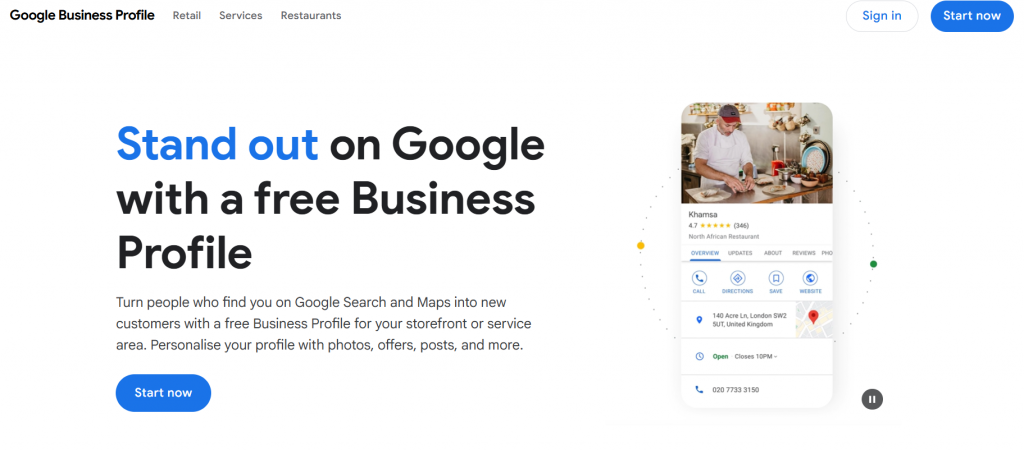Key takeaways:
- Yes, you can set up and use a Google Business Profile without a website. It will list your business on Google Search and Maps, showing your contact info, location, and reviews.
- While Google Business Profile works for basic visibility, a website offers far more control and opportunities for growth.
- You want to have both a Google Business Profile and a professional website to elevate your business to new heights.
If you want to know where to buy something or you want to know about a business, the first thing you’ll probably do is search on Google. Then, you’ll click whatever result comes first. If you have a business, chances are your customers are also doing the same.
As a business owner, you want your customers to find you on Google.
There’s two ways to do this: First, through a Google Business Listing. Second, by a traditional website. But is a Google Business Listing enough? Or do you really need a website? Let’s explore both options and see how they can help your business.
What is a Google Business Profile?

Google Business Profile (GBP), formerly known as Google My Business (GMB), is a free tool offered by Google that allows business owners like you to manage how your business appears across Google platforms, including Google Search and Maps. It’s particularly useful for small traditional businesses with physical stores.
When users search for your business, products/services you offer, or related terms, your Google Business Profile displays key information such as:
- Business name
- Address or service area
- Contact information (phone number, website link)
- Hours of operation
- Customer reviews
- Photos and updates
It helps your customers find your local business quickly and easily. You can also respond to reviews and post updates to engage your audience. Here’s how Google Business Profile works:

Let’s say a customer is new in Atlanta and is looking for the nearest Starbucks branch in the area. The customer would probably type “Starbucks Atlanta” on Google’s search bar. Then, Google will take you to its maps and provide the business information of the most relevant results it could find.

As a customer, it’s easier to find the physical address of shops and stores. They’ll be able to see updated information which helps with deciding whether they’re interested to visit. More information means less disappointment and smarter purchases.

What are the benefits of having a Google Business Profile
You don’t need to be the owner of Starbucks to use GBP. As a small business owner, you can also reap the benefits of a Google Business profile:
- Instant local visibility. Your business can appear in Google Maps and local search results, which is vital for attracting nearby customers. Local businesses can gain a lot from this, especially since people from outside the city aren’t usually familiar with your brand.
- Customer engagement. Respond to customer reviews, answer questions, and post updates that keep your business top of mind. Reviews help potential customers shape their impression of you. After all, most people trust what real people have to say about their experience.
- Improved local SEO. Being on Google Maps and in local search results boosts your visibility in location-based searches, especially when you optimize your GBP with accurate info.
- Free and easy to set up. Unlike building a website, setting up a Google Business Profile doesn’t require any coding or design expertise.
Why Google Business Profile alone isn’t enough
While GBP can get your business on the literal map and help local customers find you quickly, it may not be enough to convince customers you’re the best option because of:
- Customization limitations
- Marketing restrictions
- Lead capture challenges
- Lack of ownership and control
Here are significant drawbacks to relying solely on it:
Customization limitations
Google Business Profile is constrained by Google’s template. This means you can’t fully reflect your brand’s uniqueness. There’s no flexibility in terms of layout or functionality — you can’t control the design, messaging, or user experience beyond the limited options Google provides.
Marketing restrictions
While you can post updates or promotions, the marketing capabilities are minimal compared to a website. Google Business Profile doesn’t allow you to run targeted ads, set up email marketing campaigns, or integrate with other marketing tools that could enhance customer engagement.
Lead capture challenges
A Google Business Profile doesn’t offer a direct way to collect leads, such as contact forms, quote requests, or customer sign-ups. All of these features are standard on a website and are crucial for converting interest into actual sales or services.
Lack of ownership and control
You don’t own Google Business Profile — Google controls the platform, and it can change how it works at any time. If Google alters its algorithm, changes its policies, or removes your profile for any reason, your business could lose its online visibility overnight.
In short, GBP may have some advantages, but it also has its limitations.
| Pros | Cons |
| Free and easy to set up | No way to fully customize your business presence |
| Provides basic local visibility on Google Search and Maps | Doesn’t support advanced marketing like ads or email campaigns |
| Great for businesses with limited services or just starting out | Limited lead capture options, with no direct sales or booking features |
| Lack of control: Google can modify your profile’s visibility, and your profile can be removed or altered at any time |
Want to explore further? Check our quick guide on the Top Alternatives to Google Business Profile Websites.
Why do I need a website with my Google Business Profile?
A website is an online platform where customers can find information about your business, products, or services.
Consumegravity’s statistics states 81% of consumers do research before making decisions about their purchases. And in a 2024 study according to Search Engine Guidelines, 89% of consumers use search engines like Google to do that research.
A customer might search your store on the internet to learn more about you and what you have to offer. But if Google Business Profile already provides users with information, why do you still need a website?
Here’s a deeper look at why a website is essential for your business:
- Wider visibility across the internet
- A home for your brand
- Better advertising opportunities
- Email marketing and list building
- Lead generation tools
- Online sales and bookings
- Professional credibility
1. Wider visibility across the internet
A Google Business Profile only shows up on Google Search and Google Maps, but a website gives you visibility across all search engines — including Bing, Yahoo, Firefox, DuckDuckGo, and niche search engines relevant to your industry. This broadens your reach and allows you to attract customers who may use different search platforms.
Your website can also be submitted to local and industry-specific directories where customers in your niche may search. Google Business Profile doesn’t have this capability.
2. A home for your brand
With a website, you have full control over how your brand is represented. You can choose your colors, typography, layout, and content for optimum visual branding. This is crucial because your website serves as the digital storefront for your brand. Google Business Profile is helpful for basic contact details and a map, but it doesn’t allow you to convey the unique qualities of your business, such as your story, your products/services, or your company’s mission and vision.
A website also allows you to display high-quality images, videos, and customer testimonials that build credibility and trust, which Google Business Profile doesn’t support in the same way.
3. Better advertising opportunities
A website acts as the central hub for your digital marketing campaigns. Whether you’re running paid ads on Google, Facebook, Instagram, or other platforms, a website gives you a landing spot to direct paid traffic. Ads are more effective when you can target specific audiences and direct them to a page designed for conversion.
Google Business Profile, on the other hand, offers limited options for ad placements and does not allow for retargeting or detailed segmentation.
4. Email marketing and list building
With a website, you can implement strategies to capture customer information, such as email addresses. A simple email opt-in form can be used to collect customer emails, allowing you to send personalized messages, special offers, or newsletters to keep them engaged and encourage repeat visits.
Email marketing is one of the most effective marketing channels, providing a direct line to your audience, which Google Business Profile cannot facilitate.
5. Lead generation tools
A website provides built-in tools for lead generation, such as contact forms, free quote requests, or even chatbots to capture customer inquiries in real time. By collecting and managing leads through your website, you can streamline your sales process.
Google Business Profile doesn’t offer these tools, and relying solely on it means you miss out on capturing valuable customer information.
6. Online sales and bookings
If you offer products, services, or gift cards, a website is where customers can buy directly, at any time. Websites also provide booking functionalities, allowing customers to schedule appointments, book a consultation, or reserve a service. Google Business Profile isn’t an eCommerce site and doesn’t support any of these capabilities.
7. Professional credibility
A professional website shows that you are established, serious, and committed to your business. For small and medium-sized businesses, a website is often the first impression customers will have. A well-designed site builds trust and confidence in your brand, helping you stand out in a crowded market.
Google Business Profile vs website: Side-by-side comparison
While Google Business Profile is a great tool for visibility, especially for small and local businesses, it does have limitations. Meanwhile, some people may still be skeptical about investing in a website. Let’s compare and breakdown each.
| Feature | Google Business Profile | Website |
| Ownership | Controlled by Google | 100% yours |
| Search reach | Google only | All major search engines |
| Customization | Limited | Fully tailored to your brand |
| Marketing integration | Minimal | Works with ads, email, social media |
| Lead capture | No forms | Contact forms, pop-ups, quote requests |
| Sales capabilities | None | Full eCommerce and booking options |
| Analytics | Google Insights only | Advanced analytics tools |
| Review management | Directly managed in Google | No built-in review system |
| Local SEO | Optimized for local searches | Can be optimized for local SEO |
Google Business Profile is ideal for local visibility, offering features like local SEO, review management, and basic analytics. However, it has limited customization and lacks advanced capabilities like eCommerce or lead capture. A website gives you full ownership, customization, and the ability to integrate advanced marketing tools like ads and sales features, offering broader reach and control over your online presence.
While Google Business Profile is a great starting point for local visibility and quick customer engagement, a website offers more control, customization, and advanced features that drive long-term growth.
How Google Business Profile and a website work together
What if you don’t have the time or resources yet for website development? You can always make a Google Business Profile without a website for a start. However, as we’ve mentioned before, there are pros and cons to this setup.
Sure, Google Business Profile helps with visibility, but for sustained growth, branding, and customer relationships, you might want to consider building a professional website in the future.
You don’t need to pick just having either. Actually, having both can help your business more.
When you type “Starbucks” into Google search, you’ll find its website directly on the top result. Anyone who wants to check their menu or find promotions, rewards, and discount offers can go to their website to find more details. This is best for potential customers who aren’t planning to buy yet but are curious of what Starbucks has to offer.

But customers on the go probably don’t want to know about who Starbucks is and what their mission and vision are. They probably want to buy coffee right away. In an unfamiliar place and with so many Starbucks branches across the cities, users want something with quick information.
That’s where your Google Business Page can help.
In fact, right below Starbucks’ official website is the Google Maps with all the nearest branches’ business profiles. When it comes to search, both are important depending on what the customer needs at that moment.

How to add your business to Google without a website
- Go to Google Business Profile and click Start Now.
- Sign in with your Google account.
- Enter your business name on the field provided.
- Choose your business type. Indicate if it has a physical location or a service area.
- Enter your business category.
- Add your business location, starting with your country, city, street, and postal code. If a business is near your location, it will ask you to confirm if it’s yours or if it doesn’t match.
- Add contact info and business hours.
- Verify your business by postcard, phone, email, or video.
- Upload photos and write a detailed description of your services.
Pair your Google Business Profile with a website
While your Google Business Profile is a great starting point, a website takes your online presence to the next level. It helps you grow your customer base, build your brand, and run more effective marketing campaigns.
Your Google Business Profile helps you get noticed. Your website helps you get chosen.
Ready to build your professional website? Complement your Google Business Profile page with a proper business website made with Network Solutions’ easy-to-use website builder. You can choose from hundreds of beautiful designs, add eCommerce features and so much more.

Not time to DIY? Our professional team of experts can handle your web development, design and digital marketing campaigns all at once.
Frequently asked questions
Yes. You can leave the website field blank when creating your profile, but adding a website increases trust and conversions.
Yes. Service-area businesses can list their service zones instead of a physical address.
No, but it’s strongly recommended if you want to grow your customer base and run ads or email campaigns.
Yes. Google Workspace allows you to set up a business email without a site. However, pairing it with a matching domain boosts your brand’s professionalism.
Yes. Linking your Google Business Profile to your website improves local SEO, helping your website rank higher in search results.
No. While it increases visibility, Google Business Profile doesn’t offer direct sales capabilities like an eCommerce website would.




